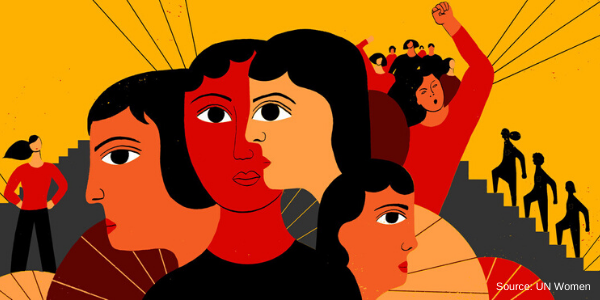MINIMIZING CRIME AGAINST WOMEN IN WORKPLACES
AUTHOR: HARSHIKA SINHA, SYMBIOSIS LAW SCHOOL, HYDERABAD
For women, workplace safety is about more than just abiding the law. It is about equality, dignity, and being able to succeed without worrying about being mistreated and undermined. India’s long-standing patriarchal norms and deeply ingrained social hierarchies make this issue more urgent. Even as more women pursue careers in a variety of fields, they frequently encounter covert sexism and, frequently, overt harassment[1]. The magnitude of this issue necessitates a commitment to structural reform that is real rather than symbolic, empathy for women’s lived experiences, and a look beyond statistics and legal provisions[2].
Even though legal frameworks have changed significantly over the last few decades, there are still concerning discrepancies between the written law and actual practice. Many women still have to deal with the harsh reality that hierarchies and reputations are frequently valued more highly at work than the welfare of survivors[3]. One only needs to read the accounts of professionals who describe enduring repeated microaggressions, inappropriate remarks disguised as jokes, or unsolicited advances that make every workday a tense negotiation. Even more troubling are cases where women, who file complaints face retaliation, transfer, or isolation. These experiences, which are frequently kept hidden, highlight how structural indifference and unequal power dynamics impede true safety and inclusion[4].
An important turning point was the ruling in Vishaka v. State of Rajasthan (1997)[5] by the Supreme Court of India. The horrific gang rape of a grassroot social worker served as the impetus for that case, which highlighted how sexual harassment at work is a violation of the Articles 14[6], 15[7], 19(1)(g)[8], and 21[9] of the Constitution. It acknowledged that if women’s workplaces are unsafe, they would feel a sense of freedom or equality in the society. The resulting Vishaka Guidelines[10] gave employers a blueprint to prevent and redress complaints, a blueprint that became law in the Sexual Harassment of Women at Workplace (Prevention, Prohibition and Redressal) Act of 2013[11], often referred to as The POSH Act[12].
Yet despite this clear legal mandate, implementation across workplaces remains uneven. Some companies conduct periodic trainings and have well-functioning Internal Complaints Committees (ICCs), while others relegate these obligations to a purely procedural formality[13]. Even a decade after the POSH Act came into force, many women report that they do not know who is in the committee, what the complaint-processes look like, or even if they have the right to report anonymously. Data from the National Crime Records Bureau and civil society surveys show that incidents continue to rise, not necessarily because more crimes occur, but because more women dare to speak up[14]. But a worrying proportion of complaints are dismissed or left pending due to bias, lack of expertise, or organizational reluctance to take decisive action (Ministry of Women and Child Development Report, 2021). Workplaces cannot become safer, if the laws are not being used effectively[15].
The culture surrounding workplace hierarchies makes things even more complicated. Perpetrators are too frequently influential coworkers or superiors, which discourages victims from coming forward[16]. More than they fear about suffering another uncomfortable day, many women fear jeopardising their career prospects. Some feel compelled to leave their jobs entirely, a painful choice that effectively rewards perpetrators and upholds the status quo. Even where companies profess zero tolerance, informal channels of gossip and subtle discrimination against those who report can make an already difficult process even more arduous[17].
In practice, this means that creating a formal legal structure must go hand in hand with fostering a culture that supports and believes women. That culture cannot emerge overnight. It requires sustained educational efforts and serious investment in sensitisation, especially among men in leadership roles who may not appreciate how casual remarks or “harmless” jokes contribute to a hostile atmosphere[18]. Interactive workshops that explore unconscious bias and concrete examples of inappropriate behaviour can be much more effective than generic presentations. Organizations need to view these sessions as core professional training, integral to one’s role and not merely an HR box to check. Moreover, these programs need to include guidance for men on being proactive allies who recognize harmful behaviour in themselves and others, and take responsibility for calling it out.
Companies also need to recognize that the POSH Act sets the floor, not the ceiling. Legal compliance is vital, but the most progressive organizations go beyond this baseline by creating additional safeguards[19]. For instance, they make it clear that all managers, regardless of their seniority, must receive specialized training in handling complaints with sensitivity and discretion. To prevent complaints from lingering, internal policies can require resolution deadlines that are even more stringent than those stipulated by law. To ensure that victims never feel alone during the reporting process, some organisations set up peer-support networks where skilled volunteers can offer an understanding initial response. Transparency is also necessary for accountability[20].
Publicizing anonymized data on the number of complaints received, investigated, and substantiated can help counteract cynicism and fear of reprisal. Employees deserve to know that complaints lead to action, not just an apology and a file closed under management’s desk. Audits of ICCs and periodic reviews of policies can help identify where the process is falling short and build trust that these mechanisms are more than symbolic. External reviewers, such as trained legal professionals or gender experts, can also help enhance committee credibility and ensure that decision-making is impartial.
The informal sector poses its own serious challenges. Many women work outside formal offices as agricultural labourers, domestic help, street vendors, or in small workshops where formal protections and committees simply do not exist[21]. The POSH Act created Local Committees at the district level to support these women, but these bodies often exist only on paper. Poor funding, lack of trained members, and low awareness mean that informal workers rarely receive the protections they are entitled to. Addressing these gaps requires government leadership, sustained public outreach, partnerships with civil society organizations that already have grassroots networks, and simplified reporting procedures that allow women to file complaints without fear or bureaucratic hurdles. The formal economy cannot thrive fairly if the informal economy is left behind[22].
More importantly, reducing crime against women requires a shift in societal perceptions. Laws and policies are important, but harassment will continue as long as societies continue to value male privilege over women’s dignity. Educational institutions must incorporate lessons on gender respect and mutual consent into their curriculum. Parents must raise sons who appreciate their female peers as equals rather than as objects of scrutiny or conquest. Leaders must model integrity in their own behaviour and make it clear that respect is a non-negotiable standard for advancement. These cultural changes are slow and often contested, but they are the most enduring tools for preventing harassment before it happens[23].
There is also considerable scope for leveraging technology to improve reporting and accountability. Apps can help women access information about their rights under the POSH Act and connect them to legal and psychological support services. Data analytics can also be used by businesses to pinpoint teams or departments that receive complaints frequently, enabling early intervention through manager scrutiny or focused training. But human empathy and dedication to leadership cannot be replaced by technology. A truly safe working environment is one where the tools of reporting and redress exist alongside an enduring culture of fairness and respect[24].
In tackling these complex issues, intersectionality must also be kept in view. Women who belong to marginalized groups, whether due to their caste, religion, disability, sexuality, or socioeconomic background, often face compounded discrimination and fear harsher consequences for reporting[25]. Effective policies must recognize this diversity and ensure that committee members and managers receive specialized training to support all victims sensitively. Complaints processes need to reflect these realities too, allowing for flexible accommodations such as translators, mental health support, and extended deadlines where needed.
Each of these measures, legal protections, cultural change, better training, more transparent reporting, is part of a larger whole. None can stand on its own if the goal is truly to minimize crime against women in workplaces[26]. Laws like the POSH Act and Vishaka Guidelines will remain under-utilized unless organizations move past mere compliance and make safety a core part of their institutional identity. Leadership must embrace this as a personal responsibility rather than a legal burden. Employees must believe that their voice matters and will be heard. The wider public must recognize that the struggle to make workplaces safer is part of a larger fight for social justice and equality[27].
Ultimately, minimizing crimes against women is not a task for one committee or one policy document, rather it is an ongoing, collective process that requires honesty and commitment. When women feel supported enough to report misconduct without fear of reprisal, when complaints are dealt fairly and promptly, and when all employees recognize their role in upholding respectful behaviour, then workplaces will become not only safer but also more productive and equitable. Change is undoubtedly difficult, especially given the weight of centuries-old attitudes and expectations. But the cost of inaction is too great, measured in talent lost, trauma endured, and futures dimmed. The law provides a structure for reform and society must provide the will. Only then can workplaces become spaces where every woman’s right to dignity and safety is upheld as a matter of practice, not aspiration.
“The author has solely undertaken the research, writing, and editing of this manuscript.”
[1]Changeincontent Bureau, Workplace safety for women: A right still under siege in India, Changeincontent (Sept. 24, 2024), https://www.changeincontent.com/workplace-safety-for-women-india-harassment-solutions/.
[2]Strengthening women’s empowerment and gender equality in fragile contexts towards peaceful and inclusive societies: A systematic review and meta‐analysis, PMC https://pmc.ncbi.nlm.nih.gov/articles/PMC8904729/.
[3]Creating safe and empowering public spaces with women and girls, UN Women Headquarters https://www.unwomen.org/en/what-we-do/ending-violence-against-women/creating-safe-public-spaces.
[4] Tsai, “You’re Just Taking a Man’s Job”: A Multi-Level Analysis of Workplace Gender Inequality Experienced by Women Police Officers, https://escholarship.org/uc/item/6r3922qs.
[5] Vishaka v. State of Rajasthan, (1997) 6 SCC 241
[6] INDIA CONST. art. 14.
[7] INDIA CONST. art. 15.
[8] INDIA CONST. art. 19, cl. 1(g).
[9] INDIA CONST. art. 21.
[10]The Vishaka Guidelines: A step against Sexual Harrasment, IPleaders (Mar. 2, 2020), https://blog.ipleaders.in/vishaka-guidelines/.
[11] The sexual harassment of women at workplace (prevention, prohibition and redressal) act, 2013, 14 (India Code 2013).
[12] The sexual harassment of women at workplace (prevention, prohibition and redressal) act, 2013, 14 (India Code 2013).
[13]“Crime Not Rising, More Women Are…”: Panel Chief On New Central Data, (Dec. 7, 2023), https://www.ndtv.com/india-news/rise-in-case-numbers-as-more-women-reporting-crime-says-womens-panel-chief-4642984.
[14]NCRB data indicate more women coming out to report crime: NCW chief, (Dec. 7, 2023), https://theprint.in/india/ncrb-data-indicate-more-women-coming-out-to-report-crime-ncw-chief/1876448/.
[15]Bushra Ansari, Women’s Day: NCRB Data Shows Safety Concerns Remain in India, (Nov. 10, 2015), https://www.isdm.org.in/blog/its-womens-day-but-on-ground-little-has-changed.
[16]National Legal Services Authority Department of Justice, (Nov. 7, 2024), https://cdnbbsr.s3waas.gov.in/s32e45f93088c7db59767efef516b306aa/uploads/2025/04/20250409992422036.pdf.
[17]Peter Ragnarsson, IDEA_Rec_-1-53_corr8upg.indd, (Feb. 2, 2003), https://www.idea.int/sites/default/files/publications/reconciliation-after-violent-conflict-handbook.pdf.
[18]Women empowerment issues – Jobs,Reservation and education, Civilsdaily (June 24, 2025), https://www.civilsdaily.com/story/women-empowerment-issues-jobsreservation-education/.
[19]Legal Benefits of a Robust PoSH Policy for Your Company, Complykaro (June 5, 2025), https://complykaro.com/legal-benefits-robust-posh-policy-for-your-company/.
[20] Rachan Sareen & Surabhi Dhingra, The POSH Act in India: Progress, Shortcomings, and the Path Forward, 12 International Journal of Advanced Social Sciences (2024).
[21] Avanti Deshpande, Does The POSH Law Protect Women Working In The Unorganised Sector?, ungender (Jan. 6, 2021), https://www.ungender.in/sexual-harassment-against-women-in-the-unorganised-sector/.
[22] Dr. Shikha Dube & Reenu Bairagi, Analyzing How Women Workers in Informal Sector Are Vulnerable to Exploitation and Their Legal Protection, 3 International Journal of Legal Studies and Social Sciences 625 – 638
[23] Gender Equality in the Modern Workplace, International Association of Women Judges (Apr. 25, 2024), https://www.iawj.org/content.aspx?page_id=2507&club_id=882224&item_id=5240&pst=24181.
[24] Rajesh, POSH Compliance and Women Safety Apps for Safer Workplaces, I’M SAFE ORGANISATION (Apr. 28, 2025), https://org.imsafe.app/how-posh-compliance-shapes-better-safety-apps-for-women-at-work/.
[25] Why Does the POSH Act, 2013 Only Protect Women?, https://www.ilms.academy/blog/why-does-the-posh-act-2013-only-protect-women.
[26] All you need to know about POSH Act, https://elearnposh.com/posh-act/.
[27] Ayush Chandra, An In-Depth Analysis of the Three Major Elements of the POSH Act: Prohibition of Sexual Harassment, Internal Complaints Committee, and Punishments for Violations » LegalOnus, (Dec. 14, 2024), https://legalonus.com/an-in-depth-analysis-of-the-three-major-elements-of-the-posh-act-prohibition-of-sexual-harassment-internal-complaints-committee-and-punishments-for-violations/.


